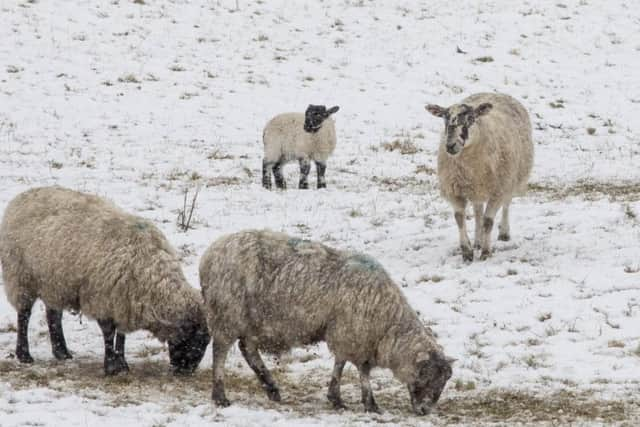Scots sheep farmers appeal for emergency aid after '˜brutal' weather
Whiteout conditions and freezing temperatures have turned Scotland’s sheep farms into graveyards, an industry chief claimed last night.
Ten times the number of Lambs and Ewes are dying due to a number of factors, not least The Beast from the East.
Advertisement
Hide AdAdvertisement
Hide AdFarmers were already struggling to feed their flocks as last summer’s rain put paid to a good harvest of winter feed.


But thousands of animals have perished in the last five weeks, suffocated as they try to shelter from driving snow and frozen in sub-zero spring temperatures.
One businessman who is charged with removing carcasses from farms said that while five or six lambs would die in an average year, he is removing 50 and 60 at a time.
On some farms, he has uplifted 200 dead sheep and lambs, bundled into huge sacks.


“This has been brutal weather,” said George Milne, Scottish development officer for the National Sheep Association.
“These are killer conditions for young lambs.
“The last few weeks have been as bad as it’s been for a long time.
“The Perfect Storm began last summer, when we did not have two dry days in a row. This meant that winter feed was not produced in sufficient numbers.
“Then we had the Beast from the East. And since then, the lack of grass growth means the lambs are unable to eat outdoors.
Advertisement
Hide AdAdvertisement
Hide Ad“Some people lamb indoors while others lamb outdoors. Anyone doing that will be in dire straits.”
He confirmed an approach for emergency help is to be made to the Scottish Government.
Ken Fletcher, editor of the Scottish Farmer, said his staff were receiving reports that carcasses were being collected at a rate of 50 tons a day once the Beast from the East had passed.
But, he added:”The cold weather and snow since Easter has just compounded it.
“Farmers living up on the hills have had worse snow than us in the cities. April 1 was the official start to the hill lambing season. The chances of a five-day-old lamb surviving in this weather are not very good.
“We have also received some horrific pictures after flocks were attacked by dogs. We have recently carried articles about concern for the mental health of farmers – these conditions will do little to improve that.”
Harry Johnston is boss of Grayshill Knackery in Cumbernauld, North Lanarkshire, one of five companies north of the border authorised to remove animal carcasses from farms.
He said: “It is just constant. Some farmers have lost 100 sheep. We have been removing huge bags of dead lambs for weeks now.
Advertisement
Hide AdAdvertisement
Hide Ad“Some areas have fared worse than others. It was bad down in Peebles, then New Cumnock, Fintry and Milton of Campsie.
“A farmer may usually lose five or six during the lambing season but we are taking away 50 or 60.
“And the farmer has to pay us each time we remove an animal. A cow costs £100.”
A Scottish Government spokesperson said:“We appreciate the challenges that Scottish farmers have faced due to the recent weather conditions and are working with relevant partners to support them.
“Whilst we would expect farmers to make every effort to comply with animal by-product regulations, we encourage local authorities to take a pragmatic approach to enforcement, particularly in winter and poor conditions in upland areas.
“We will continue to engage with the farming community and local authorities, and are always open to dialogue.”
